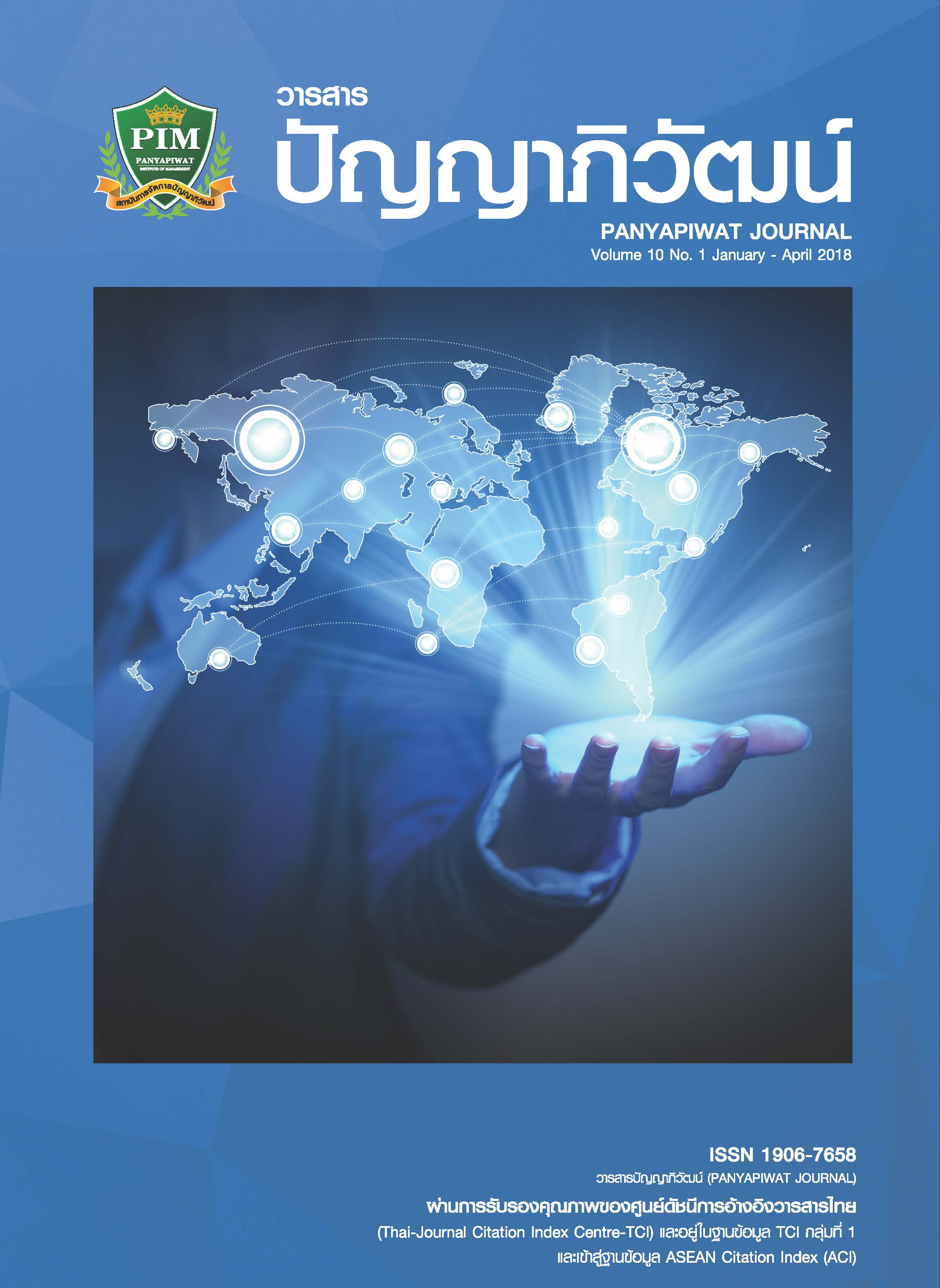การธำรงรักษาพนักงานกลุ่มเจนเนอเรชั่นวายที่มีความสามารถสูงในธุรกิจอุตสาหกรรมอาหารแบบครบวงจร ในเขตกรุงเทพมหานคร
Main Article Content
บทคัดย่อ
การศึกษาวิจัยครั้งนี้มีวัตถุประสงค์ (1) เพื่อศึกษาปัจจัยการธำรงรักษาพนักงานกลุ่มเจนเนอเรชั่นวายที่มีความสามารถสูงในธุรกิจอุตสาหกรรมอาหารครบวงจร ในเขตกรุงเทพมหานคร (2) เพื่อได้แนวทางการธำรงรักษาพนักงานกลุ่มเจนเนอเรชั่นวายที่มีความสามารถสูงที่สอดคล้องกับความต้องการขององค์กรในธุรกิจอุตสาหกรรมอาหารครบวงจร ในเขตกรุงเทพมหานคร วิธีการดำเนินการวิจัยแบ่งออกเป็น 3 ระยะดังนี้ ระยะที่ 1 เพื่อศึกษาปัจจัยการธำรงรักษาพนักงานที่มีความสามารถสูงกลุ่มเจนเนอเรชั่นวาย ในธุรกิจอุตสาหกรรมอาหารครบวงจร ในเขตกรุงเทพมหานคร กลุ่มตัวอย่างจำนวนทั้งสิ้น 20 คน โดยการสัมภาษณ์เชิงลึก ระยะที่ 2 นำเอาปัจจัยการธำรงรักษาพนักงานที่มีความสามารถสูง (talent) กลุ่มเจนเนอเรชั่นวาย (Generation Y) ที่ได้จากระยะที่ 1 มาสร้างเป็นแบบสอบถาม ตรวจสอบคุณภาพเครื่องมือโดยการตรวจสอบความเที่ยงตรง (Validity) โดยให้ผู้เชี่ยวชาญตรวจสอบจำนวน 5 ท่าน และการหาค่าความเชื่อมั่น (Reliability) โดยใช้ Cronbach ’s alpha ได้ค่าเท่ากับ 0.99 ผู้วิจัยเก็บข้อมูลกับพนักงานที่มีความสามารถสูง (Talent) กลุ่มเจนเนอเรชั่นวาย จำนวน 242 คน ส่วนการวิเคราะห์ข้อมูล ผู้วิจัยใช้สถิติเชิงพรรณนา ค่าเฉลี่ย (Mean) และส่วนเบี่ยงเบนมาตรฐาน (Standard deviation) ระยะที่ 3 เพื่อหาแนวทางการธำรงรักษาพนักงานที่มีความสามารถสูงกลุ่มเจนเนอเรชั่นวาย กลุ่มเป้าหมายคือ ผู้บริหารในระดับการกำหนดกลยุทธ์และนโยบายขององค์กร จำนวน 10 คน ด้วยวิธีการสนทนากลุ่ม (Focus group) ผลการวิจัยจากระยะที่ 1 พบว่า ปัจจัยการธำรงรักษาพนักงานที่มีความสามารถสูง กลุ่มเจนเนอเรชั่นวาย ทั้งหมด 7 ปัจจัย ดังนี้ 1) ค่าตอบแทนและผลประโยชน์ 2) ผู้บังคับบัญชา หัวหน้างาน และเพื่อนร่วมงาน 3) ลักษณะงานที่ทำ 4) โอกาสในการเรียนรู้และฝึกอบรม 5) สภาพแวดล้อมการทำงาน 6) นโยบายขององค์กรและภาพลักษณ์ขององค์กร 7) โอกาสความก้าวหน้าทางสายอาชีพ ส่วนผลการวิจัยระยะที่ 2 พบว่า ปัจจัยการธำรงรักษาพนักงานที่มีความสามารถสูง กลุ่มเจนเนอเรชั่นวาย ที่มีค่าเฉลี่ยเรียงจากมากที่สุดไปน้อยคือ ความก้าวหน้าในอาชีพ นโยบายองค์กรและภาพลักษณ์ ลักษณะงานที่ทำ โอกาสในการเรียนรู้และฝึกอบรม สภาพแวดล้อมในการทำงาน ค่าตอบแทนและผลประโยชน์ ผู้บังคับบัญชา หัวหน้าและเพื่อนร่วมงาน ส่วนผลการวิจัยระยะที่ 3 แนวทางการธำรงรักษาพนักงานที่มีความสามารถสูงกลุ่มเจนเนอเรชั่นวาย ประกอบด้วยการปรับปรุงระบบบริหารค่าตอบแทนให้มีความเหมาะสมกับหน้าที่และความรับผิดชอบ ผู้บังคับบัญชาควรเปิดโอกาสให้ลูกน้องได้แสดงความคิดเห็นในการทำงานอย่างเต็มที่ องค์กรควรสร้างบรรยากาศในการทำงานที่เอื้อต่อการเปิดกว้าง ให้อิสระทางความคิดแก่คนเก่ง
This research objective are (1) To study the factors to maintain Generation G employees with high ability in the food industry in Bangkok. (2) Guidelines to retain talent’s Generation Y employees that are talent in the food business industry in Bangkok. The research method is divided into 3 phases, as follows: Phase 1: To study the factors to retain employee talent group Generation Y in the food industry in Bangkok. The sample size was 20 persons by in-depth interviews. Phase 2: To create a questionnaire from the factors from phase 1. To check validity quality by 5 experts and find reliability by using the Cronbach’s alpha (0.99). The researcher collected data from 242 people. The data analysis used descriptive statistics: mean and standard deviation. Phase 3: Guidelines to retain Generation Y employees that were talent in the food business industry in Bangkok. The target group who were the level of strategy and policy of the organization of 10 people by focus group. Finding from phase 1, I found that the factors to retain the talent’s Generation Y concluded 7: 1) compensation and benefits 2) supervisors and colleagues 3) tasks 4) learning opportunities 5) work environment 6) corporate policy 7) career advancement opportunities. The research resulted, phase 2, I found that the factors retained talent, the means are from the highest to the lowest were: career advancement opportunities, corporate policies, tasks, learning opportunities, working environment, compensation and benefits, supervisors and colleagues. The finding of phase 3 guidelines to retain talent’s generation Y employees to: Improve the compensation management system that were appropriated to the duties and responsibilities. Open ideas and comments in their work and create work environment for freedom of thinking.
Article Details
“ข้าพเจ้าและผู้เขียนร่วม (ถ้ามี) ขอรับรองว่า บทความที่เสนอมานี้ยังไม่เคยได้รับการตีพิมพ์และไม่ได้อยู่ระหว่างกระบวนการพิจารณาลงตีพิมพ์ในวารสารหรือแหล่งเผยแพร่อื่นใด ข้าพเจ้าและผู้เขียนร่วมยอมรับหลักเกณฑ์การพิจารณาต้นฉบับ ทั้งยินยอมให้กองบรรณาธิการมีสิทธิ์พิจารณาและตรวจแก้ต้นฉบับได้ตามที่เห็นสมควร พร้อมนี้ขอมอบลิขสิทธิ์บทความที่ได้รับการตีพิมพ์ให้แก่สถาบันการจัดการปัญญาภิวัฒน์หากมีการฟ้องร้องเรื่องการละเมิดลิขสิทธิ์เกี่ยวกับภาพ กราฟ ข้อความส่วนใดส่วนหนึ่งและ/หรือข้อคิดเห็นที่ปรากฏในบทความข้าพเจ้าและผู้เขียนร่วมยินยอมรับผิดชอบแต่เพียงฝ่ายเดียว”
References
Axelrod, B., Michaels, E. & Handfield-Jones, H. (2001). The War for Talent (2nd ed.). Brighton:Harvard Business Review Press.
Barnard, C. (1938). The Function of the Executive. Brighton: Harvard Business Review Press.
Berger, L. A. (2004). The Talent Management Handbook: Creating Organizational Excellence by Indentifying, Developing, and Promoting Your Best People. NY: McGraw-Hill.
Cal Newport. (2012). Solving Gen Y's Passion Problem. Brighton: Haverd Business Review.
Cambridge University Press. (2005). The definition of employee talent. Retrieved December 1, 2016, from https://dictionary.cambridge.org/pronunciation/english/talent
Chompookum, T. (2005). Talent Management: a significant tool for significant persons. Chulalongkom Business School, 26(101), 1-16. [in Thai]
Collings, D. G., Mellahi, K & Cascio, W. F. (2010). The Oxford Handbook of Talent Management (2nd ed.). NY: Oxford University Press.
Dessler, G. & Huat, T. C. (2008). Human resource management: an Asian perspective. (J. Tavee paiboonwong & S. Thepchit, Trans.). Bangkok: Pearson-indochina. [in Thai]
Eric, A. (2003). Retaining the best of the best. AFP Exchange, 23(6), 48.
Erickson, T. J. & Gratton, L. (2011). Talent Management. (W. Makhasiranon & N. Sintrakarnpol, Trans.). Bangkok: Expernet. [in Thai]
Eua-areesuksakul, A. & Chantuk, T. (2016). Development of the Multilevel Talent Management Modeling for
Building Transformational Leadership Capability of Chief in Wholesale Industry of Thailand. RMUTT, 11(1), 200-214. [in Thai]
Harvard Business School. (2008). Harvard Business Review on Talent Management (2nd ed.). NY: Harvard Business School.
Kusumavalee, S. (2016). Human Resource and Organization Management and Development of Companies in the Creative Industry. HROD, 8(1), 4-31. [in Thai]
Martin, J. (2010). Human resource management. USA: SAGE publications.
Mumford, M. D. (2000). Managing creative people: Strategies and tactics for innovation. Human Resource Management Review, 10(3), 313-351.
Pimsing, P. (2015). Factors Affecting Human Resource Development for Academic Staff in Suratthani Rajabhat Universiry. Journal of Graduate School, Pitchayatat, 10(1), 45-54. [in Thai]
Porter, J. H. (2011). Attract and retain top talent Strategic Finance, 92(12), 56-61.
PwC. (2013). The talent challenge: Adapting to growth. Retrieved October 18, 2016, from https://www.pwc.com/gx/en/services/people-organisation/publications/ceosurvey-talent-challenge.html
Rueff, R. & Stringer, H. (2006). Talent force: a new manifesto for human side of business. NJ:Pearson Prentice Hall.
Sadanghaan, P. (2013). Retaining Talented People in organization. Executive Journal, 33(3), 33-38. [in Thai]
Samuel, M. O. & Chipunza, C. (2009). Employee Retention and Turnover: Using Motivational Variables as a Panacea. African Journal of Business Management, 3(8), 410-415.
Sangchan, R. & Boonsatorn, W. (2015). Human Resource Management for Promoting to Work Passion of Generation Y Employees and Retaining Talents in Organizations. HROD, 7(2), 20-42. [in Thai]
Schroer, W. J. (2012). Defining and Managing Generation. Journal of the Houehold Goods Forwarders Association of America, 7, 9-11.
Silzer, R. & Dowell, B. E. (2010). Strategy-Driven Talent Management: A Leadership Imperative. Sanfrancisco: John Wiley & Son.
Simatongtam, V., Promsuwan, S., Chanbanchong, C. & Soontornthai, W. (2015). Factors Influencing Turnover Intention of Thai Commercial Banks' Generation Y Staff. Journal of Modern Management, 9(2), 1-12. [in Thai]
Somaya, D. & Williamson, A. (2008). Rethinking the "War for Talent". MIT Sloan Management Review, 49(4), 29-34.
Treeprasitchai, T. (2014). Factors affecting employee retention of five-star in Bangkok. M. A. (Hospitality and Tourism Industry Management), Graduate School, Bangkok University. [in Thai]
Ulich, D. (1997). HR of the future: Conclusions and observations (1st ed.). NY: John Wiley & Son.

